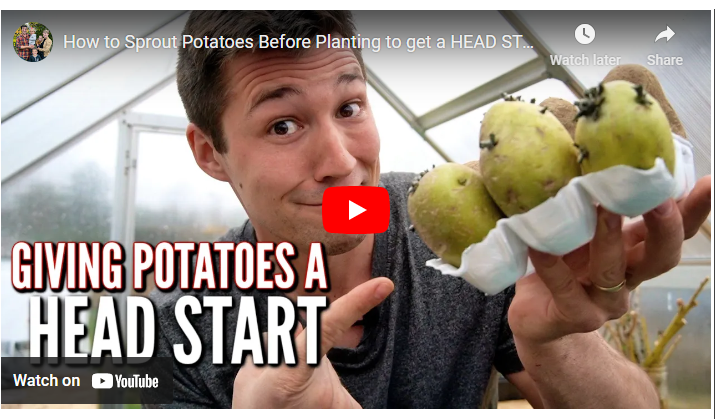Potatoes are versatile and nutritious vegetables that can be sprouted to enhance their flavor and nutritional value. Sprouting potatoes is a simple process that allows you to grow your own fresh and healthy spuds.
Potatoes are typically not sprouted intentionally but rather allowed to sprout naturally in certain storage conditions. If you wish to encourage sprouting, store potatoes in a cool, dark place with good airflow, and wait for the eyes on the potatoes to develop sprouts.
In this step-by-step guide, we will walk you through the process of sprouting potatoes, from choosing the right variety to harvesting the sprouts.
Sprouting potatoes involves encouraging the growth of small shoots from the eyes or buds of the potato. These sprouts contain increased levels of antioxidants, enzymes, and nutrients compared to regular potatoes. Sprouting also enhances the flavor and texture, making them a great addition to your culinary endeavors.
How to Sprout Potatoes: A Step-by-Step Guide
Sprouting potatoes offer several benefits. Firstly, it increases their nutritional value. During the sprouting process, the potatoes convert starches into sugars, making them easier to digest and providing a natural sweetness. Sprouted potatoes also contain higher levels of vitamins and minerals, such as vitamin C and potassium.
Read Also: [Beginners Guide] How to Sprout Beans
Additionally, sprouting potatoes can help extend their shelf life. By sprouting, you are allowing the potatoes to develop a protective layer that guards against diseases and decay. This natural defense mechanism can keep your potatoes fresh for longer.
Choosing the Right Potatoes
Not all potatoes are suitable for sprouting. It’s important to choose the right variety. Look for organic potatoes that are free from chemicals or pesticides. Varieties like Yukon Gold, Russet, or Fingerling potatoes are excellent choices for sprouting due to their texture and flavor.
Preparing the Potatoes
To prepare the potatoes for sprouting, start by soaking them in lukewarm water for about 2 hours. This helps to remove any dirt or debris and kick-starts the sprouting process. After soaking, gently scrub the potatoes with a brush to clean them thoroughly. Rinse them with water and pat them dry.
Read Also: [Beginners Guide] How to Sprout Apple Seeds
Pre-Sprouting Containers
Using pre-sprouting containers is an effective way to encourage sprout growth. These containers can be trays, egg cartons, or even paper bags. Make sure the containers have drainage holes to prevent waterlogging. Fill them with a loose, well-draining potting mix or a combination of soil and compost.
Step 1: Cutting and Drying
Cut larger potatoes into smaller pieces, ensuring each piece contains at least one eye or bud. Allow the cut pieces to dry for a day or two. This drying period prevents rotting and promotes healthy sprout development.
Step 2: Preparing the Container
Place the dried potato pieces in the pre-sprouting containers, eyes facing upward. Cover them with a layer of soil or compost, leaving the sprouts exposed. Place the containers in a warm location with indirect sunlight.
Read Also: [Beginners Guide] How to Sprout Alfalfa Seeds
Step 3: Planting the Potatoes
Once the sprouts reach a length of about 1 inch, it’s time to transplant them into the ground or larger containers to continue their growth. Choose a location with well-drained soil and ample sunlight. Dig a small hole and gently place the sprouted potato with the sprouts facing upwards. Cover it with soil, leaving the top of the sprouts exposed.
Step 4: Providing Optimal Conditions
To ensure successful sprouting, maintain a consistent moisture level in the soil. Water the sprouted potatoes regularly, keeping the soil moist but not overly saturated. Avoid overwatering, as it can lead to rotting. Additionally, provide proper ventilation to prevent mold or fungus growth.
Read Also: [Beginners Guide] How to Sprout Almonds
After planting the sprouted potatoes, continue to care for them diligently. Keep an eye on the moisture level and water as needed. Remove any weeds that may compete for nutrients and space. Monitor the growth and make sure the sprouts are getting adequate sunlight.
Harvesting
Potato sprouts typically take around 2 to 4 weeks to mature. Once the sprouts have grown to a desirable size, you can start harvesting them. Gently dig around the base of the plant and carefully remove the sprouts, ensuring you don’t damage the main plant or tubers. Harvesting the sprouts will not affect the growth of the remaining potatoes.
Can I sprout any type of potato?
While you can sprout most potato varieties, some are better suited for sprouting due to their texture and flavor. Varieties like Yukon Gold, Russet, and Fingerling potatoes are excellent choices.
Read Also: [Beginners Guide] How To Sprout a Lemon Seed
How long does it take for potato sprouts to grow?
Potato sprouts typically take around 2 to 4 weeks to reach a desirable size for harvesting.
Can I eat the sprouts raw?
It is generally recommended to cook potato sprouts before consuming them, as cooking helps neutralize any potentially harmful compounds.
Do I need a garden to sprout potatoes?
A4: No, you can sprout potatoes in containers or even in bags filled with soil. Just make sure they have proper drainage and access to sunlight.
Are sprouted potatoes safe to eat?
Yes, sprouted potatoes are safe to eat as long as they are firm, free from mold or decay, and have healthy sprouts. However, if the sprouts are green or the potatoes appear wrinkled or soft, it’s best to discard them as they may contain toxic compounds.
Read Also: [Beginners Guide] How To Sprout a Plum Seed
Conclusion
Sprouting potatoes is a rewarding and straightforward process that allows you to enjoy fresh, nutritious spuds. By following the step-by-step guide provided, you can successfully sprout potatoes and savor their enhanced flavor and health benefits. So why not give it a try and add a touch of homegrown goodness to your meals?




